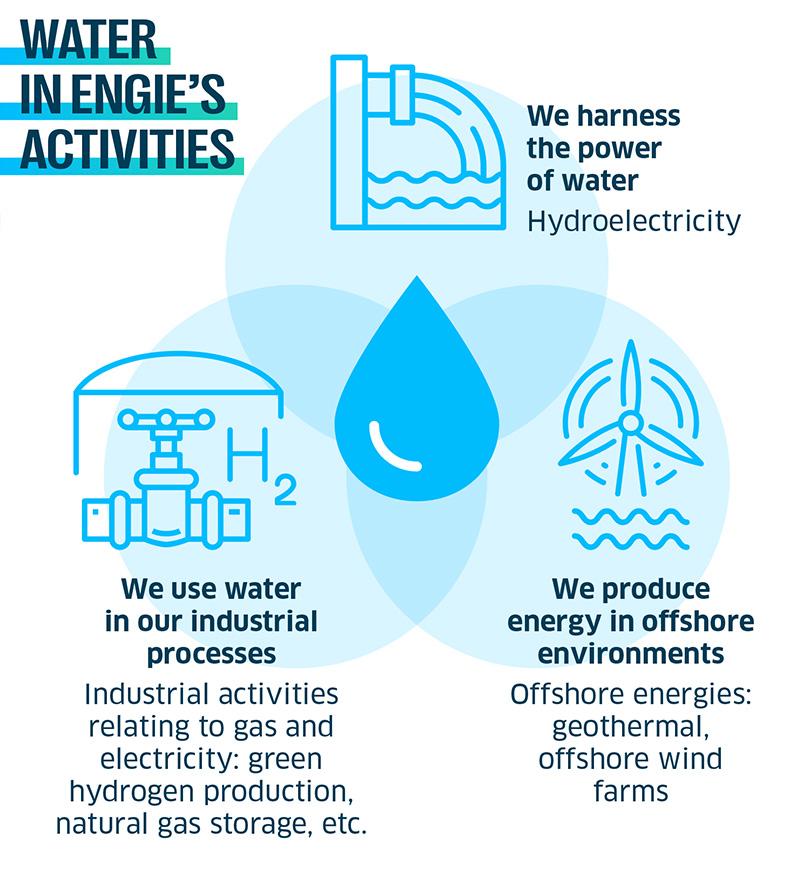
World Water Day: an essential resource for ENGIE
By ENGIE - 21 March 2022 - 17:11
Water feeds our electricity production activities, mainly through hydroelectricity and offshore wind farms, and remains indispensable to our industrial processes. For ENGIE, preserving our resources and improving the water footprint of our activities is a priority. In order to reach this goal, we support initiatives that promote marine and river biodiversity. Panorama.

Preserving our water resources: a solid and structured commitment
Much like the planet’s other primary resources, water is subject to exploitation pressures that can lead to conflicts of use and shortages. For this reason, over the last decade, the Group has been committed to optimising water management. This has resulted in the implementation of specific measures: for example, the identification of sites that are subject to water stress in order to develop action plans accordingly, contribution to the improvement of regional water management, development of technologies to reduce the impact of our discharges (ecosystem disruption), etc. We are extending this commitment in our international initiatives, such as the CEO Water Mandate, which mobilises private stakeholders on this fundamental issue.
More information on our Water Policy and our efforts to protect this resource
Case study: Wellsprings Preservation in Brazil
Since 2010, ENGIE Brazil has been involved in a preservation programme for the freshwater sources located near fourteen of our electricity production plants. Our Brazilian teams are actively working alongside government and local authorities, as well as associations and specialised NGOs, to carry out this project which has, to date, helped protect more than 2000 water sources. The notion of “preservation” encompasses various actions including the quality control of water, the construction of infrastructures to protect watercourses, the reforestation of banks (natural filtration). Local communities are highly involved and directly concerned by the health and well-being of the ecosystems. Ultimately, this approach has an impact on a wider populations since the sources feed the rivers and replenish water tables.
More information on Wellsprings Preservation
Limiting our impact on water: our priority through actions
Our goals in figures: by 2025, we plan to reduce our industrial water consumption by 15% across all of our industrial activities, and this target grows to 30% by 2030. Our approach pays particular attention to locations impacted by water stress, and includes a precise measurement of the water footprint of our activities, the implementation of effective technologies to reduce water consumption and limit the impact of industry in the regions and natural ecosystems. And we do not stand alone: we plan to include our suppliers in our approach, and integrate sustainable water management in the services offered to our customers.
Case study: reducing water stress on the arid South American coast
In Peru, our Chilca UNO plant implement the following measures: construction of a seawater desalination plant to reduce water extraction from wells and very deep-water tables, and technological change to reduce the use of water in the cooling of the power plant (installation of aerocondensers). As a result, the plant consumption of source water in m3 was reduced by a factor of 50!
In neighbouring Chile, our Mejillones LNG terminal is located in an extremely arid zone. Despite the climate, the site has found a way to produce its own drinking water thanks to the heating system which transforms LNG into gas.
More information on our water stress management programmes
Our actions in favour of marine and river biodiversity
Rivers, seas and oceans are home to some of the world’s most biodiverse environments. So, how do we plan to preserve this biodiversity? Firstly, through direct action carried out by our subsidiaries: in south-western France, SHEM facilitates the migration and out-migration of fishes by installing devices such as “fish ladders” along watercourses, allowing them to swim upstream to spawn (reproduce).
Secondly, at Group-level and via Fondation ENGIE, we support partners that are committed to the preservation of biodiversity. This is the case for the Fondation and “The Great Bubble Barrier”, which sets out to fight against plastic waste thanks to the installation of a “bubble Barrier” in Porto (Portugal) in 2022. The goal is to reduce the plastic waste that flows into the Atlantic Ocean from a single river in the region by 86% per year.
More information on “The Great Bubble Barrier”
Finally, also in favour of the marine environment, we are developing our EFGL floating offshore wind park in southern France’s Gulf of Lion, in order to manage our impact on marine and avian (birds) biodiversity. Another exciting aspect of this pilot farm is the creation of artificial habitats in a wind turbine float - a world first for the floating offshore wind sector. In particular, these spaces will serve as a nursery for crustaceans and fish.
Water: a core pillar in our CSR policy
Would you like to learn more about our water policy? Explore the scope of our water management initiatives, from the preservation of aquatic ecosystems ahead of our projects, to our water saving measures when confronted with water stress? Better understand how the water footprint is defined in order to analyse the impact of our activities on water? Discover other field examples? If so, please visit our dedicated page.
